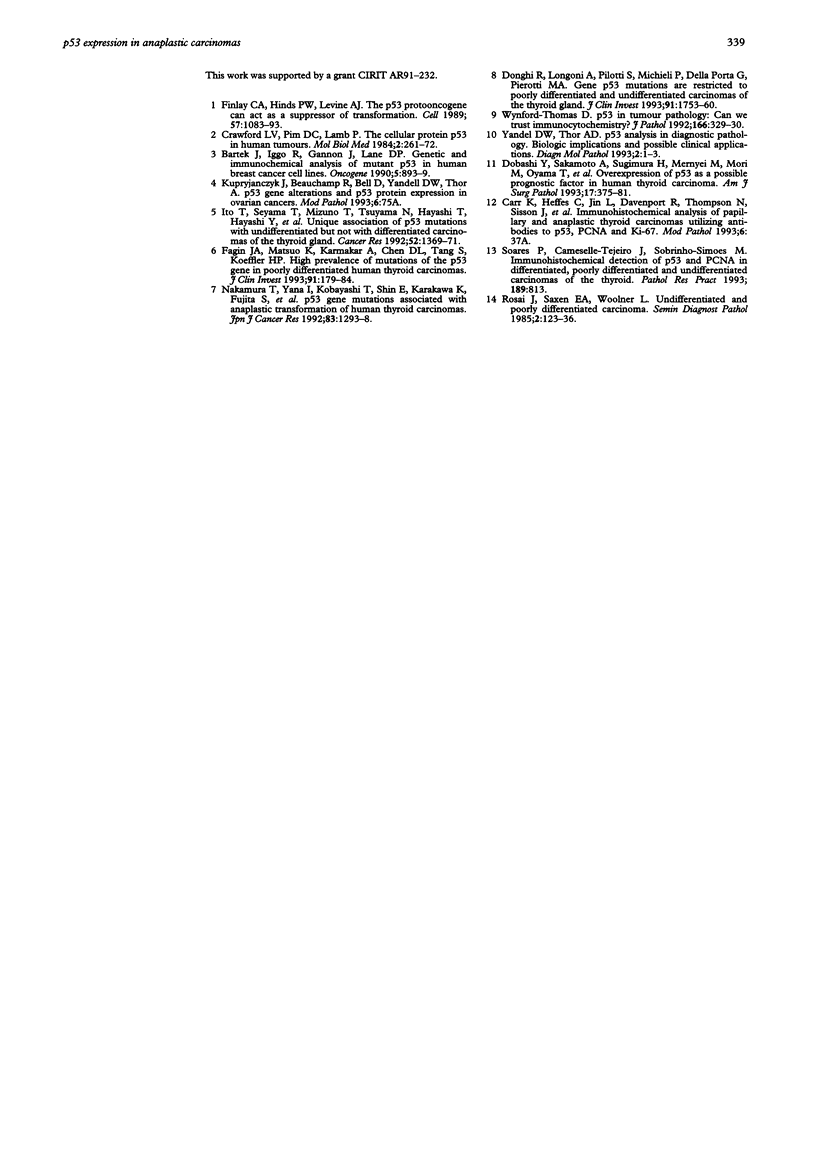Abstract
AIM--To study the expression of p53 tumour suppressor gene in anaplastic carcinomas arising from thyroid papillary carcinomas. METHODS--Formalin fixed, paraffin wax embedded tissues from four cases of anaplastic carcinomas associated with thyroid papillary carcinomas were studied by immunohistochemistry with two different p53 monoclonal antibodies. RESULTS--The anaplastic component showed nuclear immunostaining in two cases, but not in the other two. In all cases the papillary carcinoma component was negative. CONCLUSION--The results support the hypothesis that p53 stimulates tumour progression in thyroid tumours.
Full text
PDF


Images in this article
Selected References
These references are in PubMed. This may not be the complete list of references from this article.
- Bartek J., Iggo R., Gannon J., Lane D. P. Genetic and immunochemical analysis of mutant p53 in human breast cancer cell lines. Oncogene. 1990 Jun;5(6):893–899. [PubMed] [Google Scholar]
- Crawford L. V., Pim D. C., Lamb P. The cellular protein p53 in human tumours. Mol Biol Med. 1984 Aug;2(4):261–272. [PubMed] [Google Scholar]
- Dobashi Y., Sakamoto A., Sugimura H., Mernyei M., Mori M., Oyama T., Machinami R. Overexpression of p53 as a possible prognostic factor in human thyroid carcinoma. Am J Surg Pathol. 1993 Apr;17(4):375–381. doi: 10.1097/00000478-199304000-00008. [DOI] [PubMed] [Google Scholar]
- Donghi R., Longoni A., Pilotti S., Michieli P., Della Porta G., Pierotti M. A. Gene p53 mutations are restricted to poorly differentiated and undifferentiated carcinomas of the thyroid gland. J Clin Invest. 1993 Apr;91(4):1753–1760. doi: 10.1172/JCI116385. [DOI] [PMC free article] [PubMed] [Google Scholar]
- Fagin J. A., Matsuo K., Karmakar A., Chen D. L., Tang S. H., Koeffler H. P. High prevalence of mutations of the p53 gene in poorly differentiated human thyroid carcinomas. J Clin Invest. 1993 Jan;91(1):179–184. doi: 10.1172/JCI116168. [DOI] [PMC free article] [PubMed] [Google Scholar]
- Finlay C. A., Hinds P. W., Levine A. J. The p53 proto-oncogene can act as a suppressor of transformation. Cell. 1989 Jun 30;57(7):1083–1093. doi: 10.1016/0092-8674(89)90045-7. [DOI] [PubMed] [Google Scholar]
- Ito T., Seyama T., Mizuno T., Tsuyama N., Hayashi T., Hayashi Y., Dohi K., Nakamura N., Akiyama M. Unique association of p53 mutations with undifferentiated but not with differentiated carcinomas of the thyroid gland. Cancer Res. 1992 Mar 1;52(5):1369–1371. [PubMed] [Google Scholar]
- Nakamura T., Yana I., Kobayashi T., Shin E., Karakawa K., Fujita S., Miya A., Mori T., Nishisho I., Takai S. p53 gene mutations associated with anaplastic transformation of human thyroid carcinomas. Jpn J Cancer Res. 1992 Dec;83(12):1293–1298. doi: 10.1111/j.1349-7006.1992.tb02761.x. [DOI] [PMC free article] [PubMed] [Google Scholar]
- Rosai J., Saxén E. A., Woolner L. Undifferentiated and poorly differentiated carcinoma. Semin Diagn Pathol. 1985 May;2(2):123–136. [PubMed] [Google Scholar]
- Wynford-Thomas D. P53 in tumour pathology: can we trust immunocytochemistry? J Pathol. 1992 Apr;166(4):329–330. doi: 10.1002/path.1711660402. [DOI] [PubMed] [Google Scholar]





